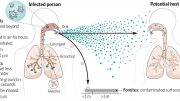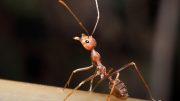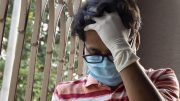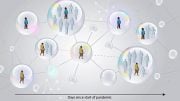
Researchers from the University of Pennsylvania and Queen’s University have developed a theoretical model that factors social dynamics into disease transmission, demonstrating that social norms around non-pharmaceutical interventions like masking during the COVID-19 pandemic create a “stickiness”, making individuals reluctant to change their behavior if it differs from the majority, which in turn significantly affects disease spread.
A model has been developed by researchers to analyze disease transmission, taking into account the influence of social dynamics, particularly the impact of social norms on masking and social distancing.
Hypersocial species, including humans, are profoundly swayed by the behaviors and actions of their peers. This was prominently observed during the COVID-19 pandemic; the extent to which people adhered to protective measures like mask-wearing and social distancing was greatly impacted by their location and company, thereby influencing the spread and prevalence of the disease.
In an effort to understand this influence further, a team of researchers from the University of Pennsylvania’s School of Arts & Science and Queen’s University in Canada have created a theoretical model for disease transmission. This model integrates the impact of social dynamics, particularly how social norms can shape non-pharmaceutical interventions (NPIs) such as masking and social distancing.
The research, published in the Proceedings of the National Academy of the Sciences, shows that social conformity creates a type of “stickiness” wherein individuals are reluctant to change their NPI usage if it differs from what others are doing.
“Generally, when there’s an infectious disease going around, rational actors are uncomfortable taking risks and will try to avoid getting sick, so naturally you’d think that they’d change their behaviors based on these concerns,” says Erol Akçay, associate professor of biology at Penn. “But it turns out populations, and by extension disease transmission rates, are equally, if not more, affected by social norms.”
The researchers aimed to better understand of how the prioritization of risk and social norms affects the adoption of NPIs during a pandemic.
To achieve this, they developed a model that considers the risk of infection, the cost of NPIs, and the social cost of deviating from NPI-usage norms. The model describes threshold dynamics in the number of individuals needed to support a behavioral change, which creates “tipping points” in the adoption of NPI behaviors where a small change in the disease prevalence can cause a significant shift in population behavior.
“Our model found that small changes in certain factors like the effectiveness of NPIs, transmission rate, and costs of interventions can lead to large changes in the rate of disease spread, or attack rate,” Akçay says.
He explains that this is in part due to people being conformist and therefore slow to adopt new behaviors such as mask-wearing, until the disease reaches levels so high that the risk perception overrides conformity, when the population tips over. Conformism works the other way, too; the new behavior persists longer in the population than it would if people cared only about their individual risks and costs. This creates distinct infection and NPI behavior waves.
As variables such as the cost or effectiveness of the NPI behavior change, it can create more or fewer waves of change and lead to more or fewer people being infected at the end of the epidemic. The researchers found that the attack rate did not increase as smoothly as anticipated; rather, it had a more “sawtooth look” when graphed. These results highlight a complex relationship between social norms and disease spread.
“It increases and then decreases, over and over, and we noticed this trend in other parameters, even the transmission rate,” says first author Bryce Morsky, who started working on this project as a postdoctoral researcher in Akçay’s lab and is now an assistant professor at Florida State University.
The team, which also includes Felicia Magpantay and Troy Day from Queen’s University in Canada, explains that when they ran an epidemiological simulation with no NPI use at the start of the epidemic they had a predictably high attack rate, and eventually, individuals began NPI usage due to fears of infection risk.
The onset of NPI usage, however, comes much later when the parameters for the cost of deviating from social norms are set higher “because if nobody’s masking you don’t want to be the first person,” Akçay says.
“So, increasing this parameter leads to a delay in masking, which drives the first wave of the epidemic much higher than it would have been if individuals were reacting to their risk levels. On the other hand, when we ran the simulation with masking and the case numbers started going down, there was a reluctance to stop masking because nobody wanted to be the first person to stop masking, which we referred to as stickiness.”
Morsky explains that the model was initially motivated by some results from a previous study investigating social norms and their effects as it relates to reciprocity behavior, where conformist behavior can induce boom-and-bust cycles in cooperative communities. Here, conformist behavior makes epidemic waves inherently more distinct than they would have been otherwise, even in the absence of external factors such as seasonal variation in transmission rates.
Akçay says that information on these trends and social dynamics can be useful for policymakers weighing decisions about responding to human behavior. And the researchers want to investigate how the interplay of different populations and socioeconomic backgrounds affects the social behaviors of disease intervention.
Reference: “The impact of threshold decision mechanisms of collective behavior on disease spread” by Bryce Morsky, Felicia Magpantay, Troy Day and Erol Akçay, 1 May 2023, Proceedings of the National Academy of Sciences.
DOI: 10.1073/pnas.2221479120
The study was supported by the One Society Network funded by the Natural Sciences and Engineering Research Council of Canada and the U.S.-Israel Binational Science Foundation.









What a load of cobblers. We now have clear evidence that
“countermeasures” such as lockdowns, social distancing, masking etc had no effect on the spread of the mythical virus but were invaluable in ensuring conformity to authority – which was clearly the overriding purpose of the sham demic.